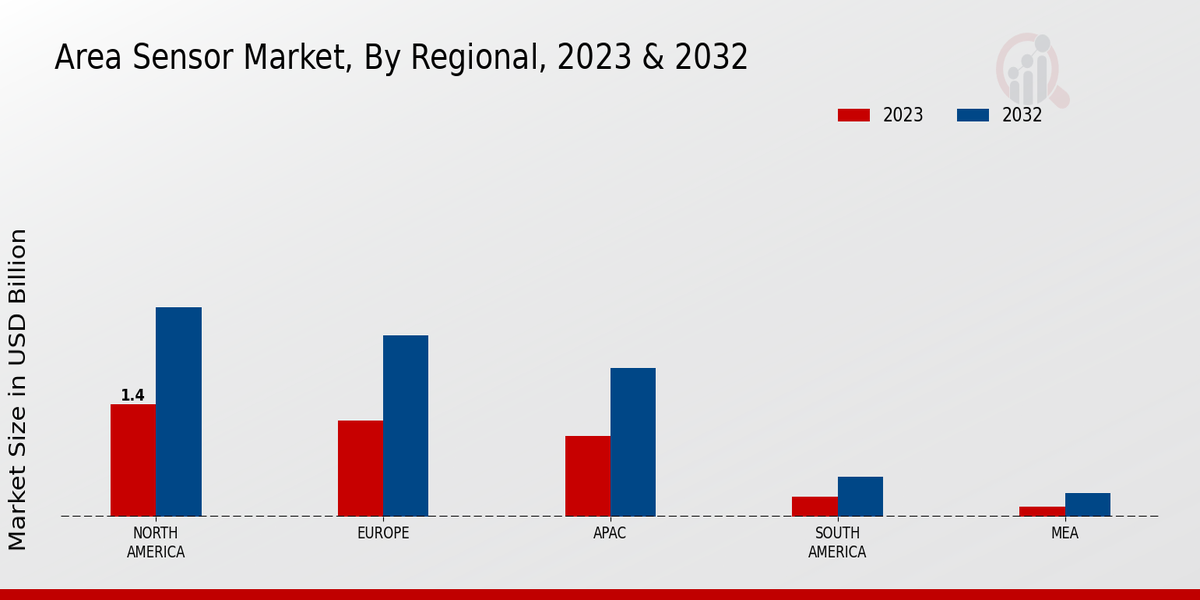Market Growth Projections
The Global Global Area Sensor Market Industry is poised for robust growth, with projections indicating a market value of 4.58 USD Billion in 2024 and an anticipated increase to 9.97 USD Billion by 2035. This growth trajectory suggests a compound annual growth rate of 7.33% from 2025 to 2035. Such figures reflect the increasing adoption of area sensors across various sectors, driven by technological advancements and rising demand for smart solutions. The market's expansion is indicative of the critical role that area sensors will play in shaping future industries and urban environments.
Growing Environmental Concerns
Environmental sustainability is becoming a critical driver for the Global Global Area Sensor Market Industry. Governments and organizations are increasingly adopting area sensors to monitor air quality, water quality, and other environmental parameters. For instance, sensors are deployed in various regions to track pollution levels and assess the impact of climate change. This trend not only aids in regulatory compliance but also enhances public awareness of environmental issues. As the global focus on sustainability intensifies, the demand for area sensors is expected to rise, contributing to the overall growth of the market in the coming years.
Rising Demand for Smart Cities
The Global Global Area Sensor Market Industry is experiencing a surge in demand due to the increasing focus on smart city initiatives. Governments worldwide are investing in infrastructure that incorporates advanced sensor technologies to enhance urban living. For instance, cities are deploying area sensors for traffic management, waste management, and public safety. This trend is expected to drive the market's growth, with projections indicating a market value of 4.58 USD Billion in 2024. As urban populations continue to rise, the integration of area sensors into city planning becomes essential, suggesting a robust future for the Global Global Area Sensor Market Industry.
Expansion of the Internet of Things (IoT)
The proliferation of the Internet of Things (IoT) is a significant catalyst for the Global Global Area Sensor Market Industry. As more devices become interconnected, the demand for area sensors that can communicate and share data is likely to increase. These sensors play a crucial role in various applications, from smart homes to industrial settings, enabling seamless data exchange and automation. The integration of area sensors within IoT ecosystems enhances their functionality and value, thereby driving market growth. As the IoT landscape continues to evolve, the Global Global Area Sensor Market Industry is expected to experience substantial expansion.
Increased Investment in Industrial Automation
The Global Global Area Sensor Market Industry is benefiting from the rising investment in industrial automation. Manufacturers are increasingly integrating area sensors into their operations to optimize processes, enhance safety, and reduce costs. For example, sensors are utilized in manufacturing plants for real-time monitoring of equipment and production lines, leading to improved efficiency and reduced downtime. This trend is likely to continue as industries seek to leverage technology for competitive advantage. The anticipated growth in this sector further underscores the potential of the Global Global Area Sensor Market Industry as businesses strive for greater operational excellence.
Technological Advancements in Sensor Technology
Technological innovations are propelling the Global Global Area Sensor Market Industry forward. The development of more sophisticated sensors, including those with enhanced accuracy and connectivity features, is likely to attract various sectors, including automotive, healthcare, and environmental monitoring. For example, advancements in IoT-enabled sensors allow for real-time data collection and analysis, which can significantly improve operational efficiency. As these technologies evolve, the market is projected to grow to 9.97 USD Billion by 2035, indicating a compound annual growth rate of 7.33% from 2025 to 2035. This growth reflects the increasing reliance on advanced sensor technologies across multiple industries.
























